Uterine polyps
Overview
Uterine polyps or endometrial polyps are benign growths inside the uterine cavity. It is formed as a result of hyperplasia of the cells of the basal layer of the endometrium (the inner lining of the uterus). One or many polyps can form on the wall of the organ. In the latter case, it is said about uterine polyposis.
Endometrial polyps are a common condition in gynecology, accounting for 6% to 20% of all diagnosed pathologies.
Uterine polyps vary significantly from as small as a sesame seed to as large as a golf ball or even bigger. They are connected to the uterine wall either by a broad base or a slender stalk.
A person may have a single uterine polyp or multiple ones. While they typically remain inside the uterus, they can move through the cervix into the vagina. Uterine polyps are most frequently observed in individuals undergoing or who have gone through menopause, although they can also occur in younger individuals.
Uterine polyps, attaching via a broad base or slim stalk, can grow several centimeters and lead to symptoms like irregular or heavy menstrual bleeding, postmenopausal bleeding, and spotting between periods.
Classification of uterine polyps
Endometrial polyps are classified with regard to the cellular structure into the following types:
- adenomatous – formed by cellular degeneration, capable of transforming into a cancerous tumor;
- glandular – formed from stromal cells, contain a small number of glands, more often appear in young women;
- glandular-fibrous – the body is formed by glands, and the stalk is made of fibrous tissue;
- fibrous – composed of connective tissue, more often formed in women over 45.
Endometrial polyps can be single and multiple. By size, the formations are classified into small, medium, and large (up to 8 cm).
Symptoms of uterine polyps
The disease can progress asymptomatically. Clinical manifestations increase in parallel with the increase in the size of polyps. The intensity also depends on the number of formations in the uterine cavity. Small polyps are usually detected accidentally – during preventive examinations or during examinations for other reasons. The main signs of polyp formation in the uterus are recognized:
- Pain in the lower abdomen
- Discomfort during or post-sexual activity
- Vaginal bleeding outside of menstrual periods
- Postmenopausal bleeding
- Menstrual cramps in the abdomen
- Excessive menstrual flow
- Menstrual cycle inconsistencies
Hyperplastic formations of the endometrium can become infected and necrotized, which aggravates the clinical picture.
Causes of uterine polyps
- Inflammatory conditions of the uterus and its appendages;
- Chronic genital infections;
- Trauma from childbirth, abortion, or dilation and curettage (D&C).
Predisposition to uterine polyposis is caused by ovarian dysfunction with an increase in the level of estrogenic hormones. Women with excessive body weight, endocrine disorders (diabetes mellitus, thyroid pathologies), and aggravated family history are prone to endometrial polyps.
Uterine polyps diagnosis
- The examination begins with the collection of anamnesis. The doctor needs to analyze the menstrual cycle, sexual activity of the woman, the consistency of childbearing function, and family history. The gynecologist collects complaints and anamnesis of the patient in detail.
- The next stage is a gynecological examination. Polyps of the uterine body are not detected visually. The exception is neoplasms of the cervical canal, which can be detected by inspection in the mirrors.
- After that, an ultrasound of the pelvic organs is performed. At this stage, the doctor can suspect the presence of an endometrial polyp. The doctor assesses the localization and the size of the formation and makes an assumption about its structure. It is impossible to establish the nature of the polyp on ultrasound accurately.
- Hysteroscopy involves inserting a thin, lighted tube called a hysteroscope through the vagina and cervix into the uterus. This allows doctors to visually inspect the inside of the uterus for diagnostic or therapeutic purposes, such as finding the cause of abnormal bleeding or removing polyps.
Uterine polyps treatment
Surgery removes abnormal tissues to prevent polyp recurrence, with the method depending on the polyp’s type and size. In cases with cancer concerns, reproductive organ removal may be necessary. Post-surgery, conservative treatment is tailored based on histology results. The gynecologist aims to identify and treat the underlying cause of the pathology using medication.
Conservative treatment of Uterine polyps
After the removal of fibrous polyps, medication is not carried out. After resection of glandular and glandular-fibrous formations, the patient requires therapy with hormonal drugs. Treatment is personalized, typically involving combined oral contraceptives or progesterone. Additional therapy by a specialist may be needed for accompanying conditions like hypertension, obesity, or diabetes.
Surgical treatment of Uterine polyps
For the treatment of endometrial polyps, minimally invasive surgical interventions are preferred. In modern clinics, polypectomy is performed during hysteroscopy. The operation is done under short-term intravenous anesthesia; in uncomplicated cases, the manipulation takes 15-20 minutes.
Hysteroscopic polypectomy is available in more than 730 hospitals worldwide (https://doctor.global/results/procedures/hysteroscopic-polypectomy). For example, hysteroscopic uterine polyps removal can be performed in 13 clinics across South Korea for an approximate price of $3.4 K (https://doctor.global/results/asia/south-korea/all-cities/all-specializations/procedures/hysteroscopic-polypectomy).
During the operation, the doctor examines uterine walls with a camera, studies the structure of neoplasms, and selects the optimal method of removal. Polyps are eliminated with the microsurgical instruments. Recently, laser and electrocoagulation techniques have been actively introduced. Tissues in the area of formation are examined in detail and scraped to remove all altered cells. In the end, the vessel feeding the polyp is cauterized.
Inpatient observation after therapeutic hysteroscopy lasts a few hours. The operation results are monitored on the 3rd to 4th day using ultrasound. Within 10-14 days, the patient is advised to refuse sexual contact, heat procedures, swimming in open water, lifting weights, and excessive physical activity.
Prevention of uterine polyps
Risk factors for polyps formation are invasive gynecological interventions (childbirth, abortion, some diagnostic procedures) and inflammatory processes.
Preventing uterine polyps involves maintaining a healthy lifestyle, managing hormonal imbalances with medical guidance, and regular gynecological check-ups for early detection and intervention.





